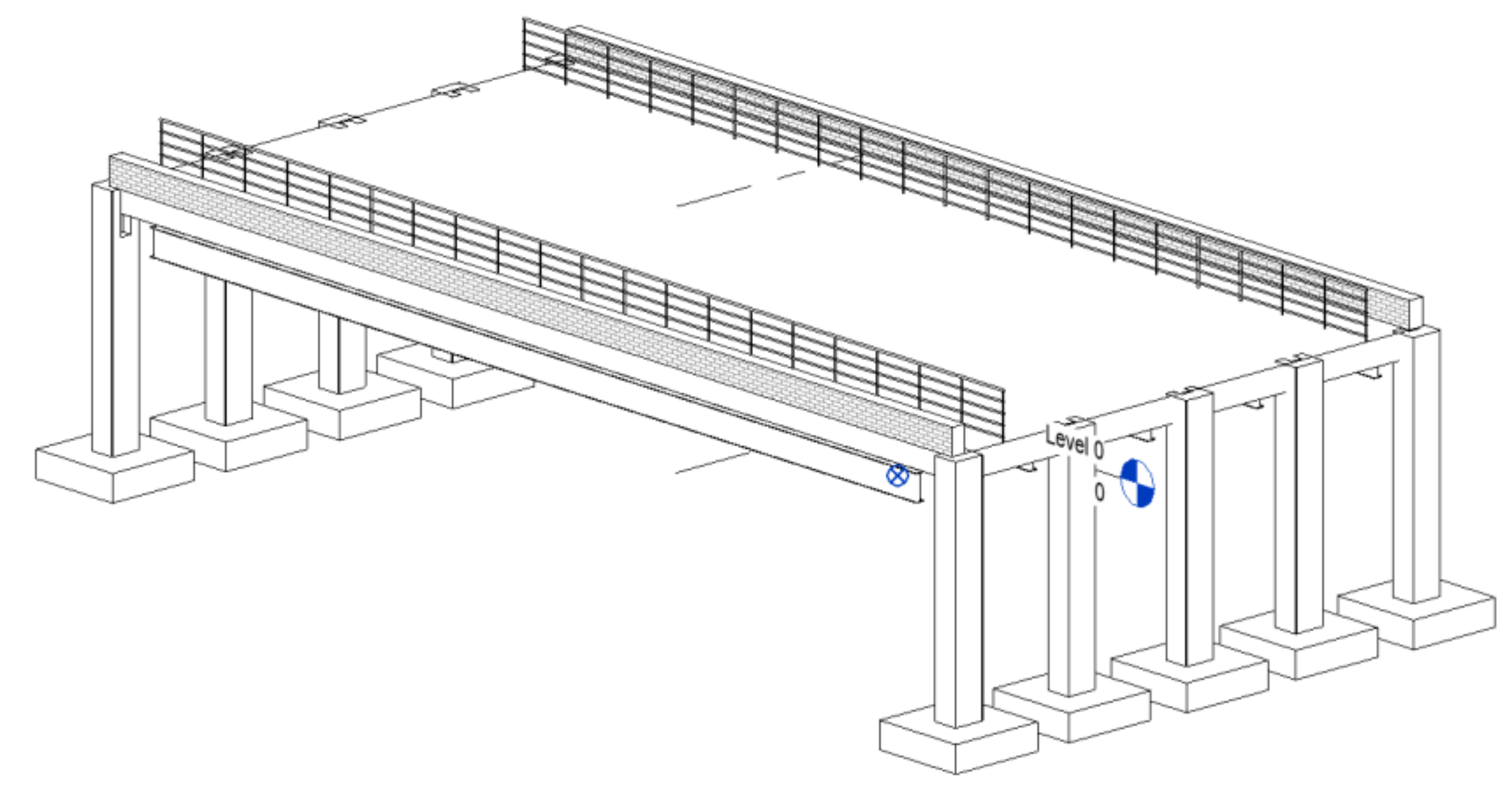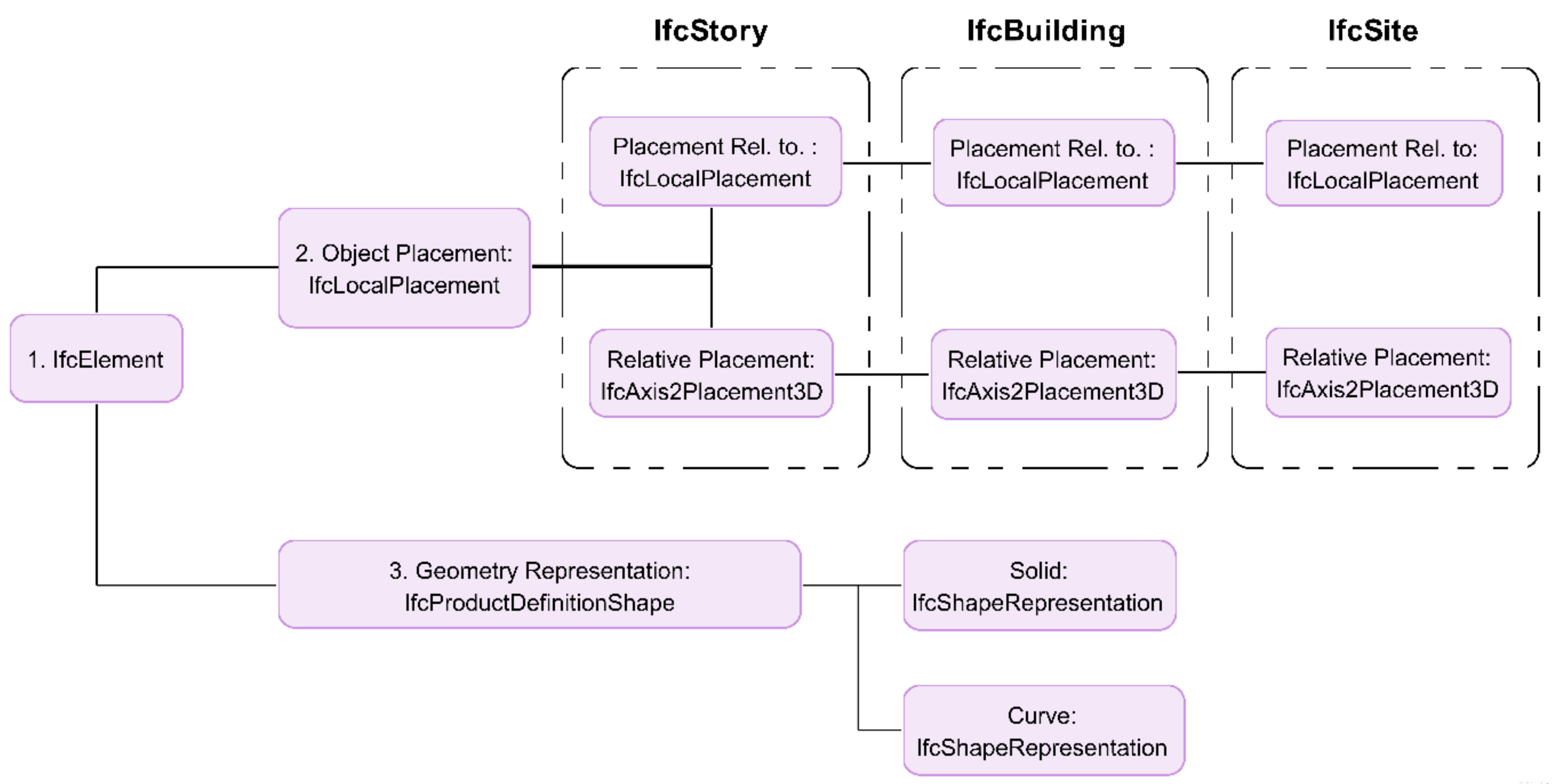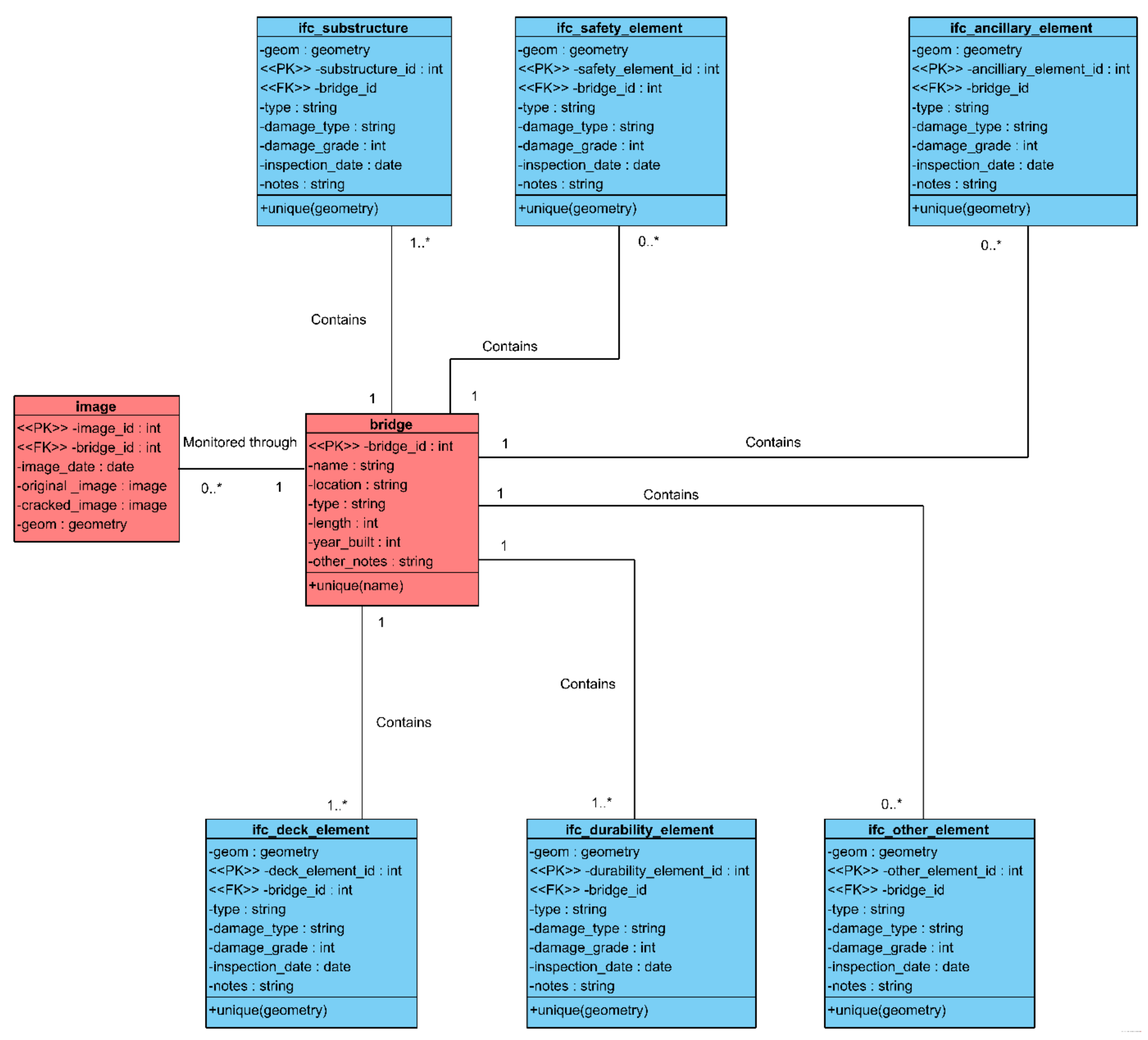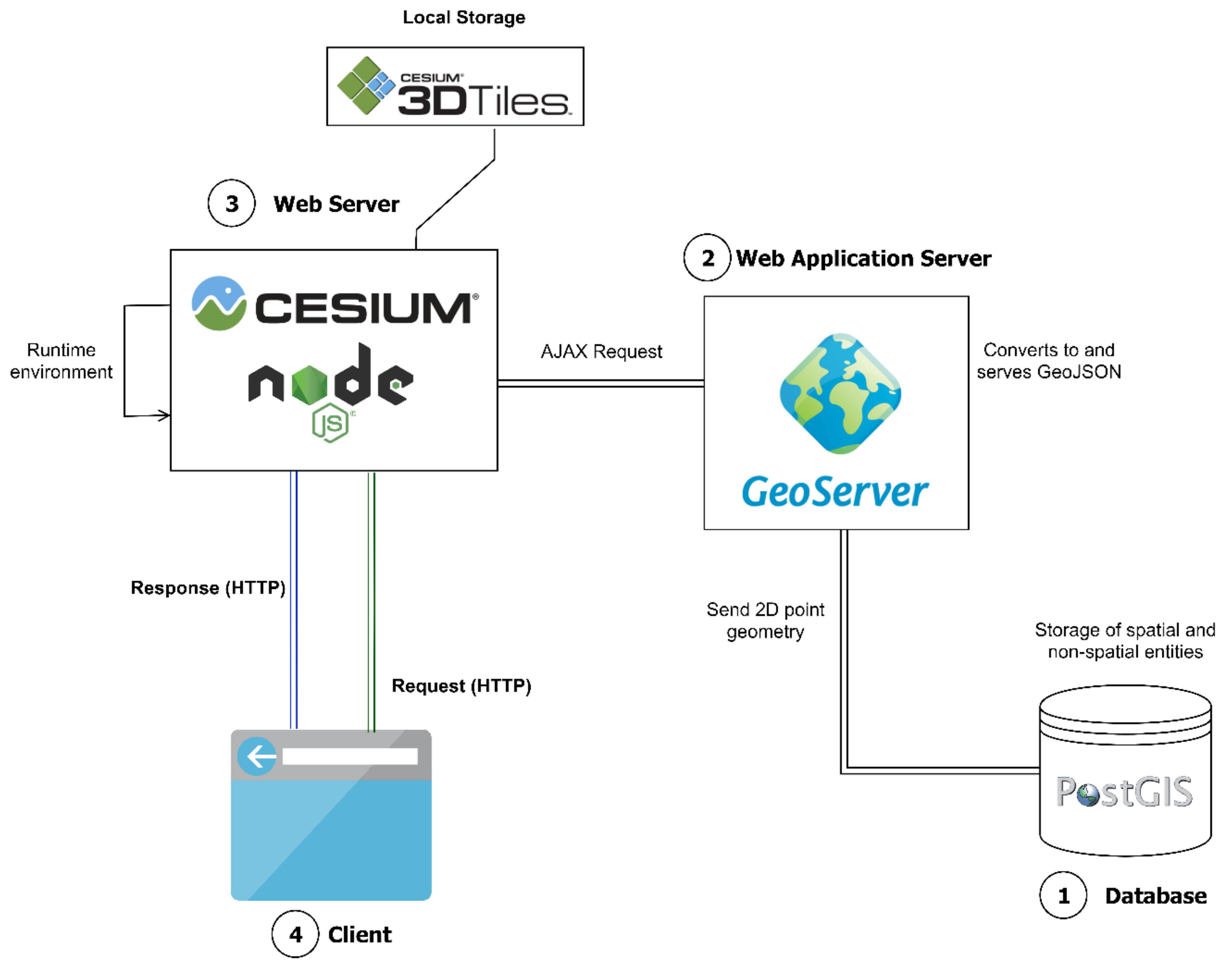A Digital Information Model Framework for UAS-Enabled Bridge Inspection
Abstract
:1. Introduction
2. UAS for Bridge Inspection and Framework for Bridge Management Systems (BMSs)
Framework for Bridge Management Systems (BMSs)
- Data acquisition refers to both the methods and technologies used for capturing digital images. Typically, wireless mobile technologies can be used to transfer real-time media captured during drone flights to an easily accessible cloud-based system. UAS have a high potential to be able to provide complete autonomous navigation in the future, removing the need for any human interaction during the data acquisition process. This will contribute towards alleviating both human and capital resource scarcity;
- Data analysis and interpretation refers to the image processing tools and algorithms recruited to analyse the digital images captured during bridge inspection. The most common interpretation technique employed are crack detection algorithms [17,18]. This involves methods to isolate cracking from the rest of the scene, using grayscale image transformations for easy detection. The end result is a “crack image” which can then be stored in the database.
- The digital information model provides data storage, processing and management capabilities for UAS and bridge data. Producing such a system is the main focus of this paper, and modelling efforts and developments will be discussed in the preceding sections. In this case, the model must be proficient in storing and integrating 3D modelling, digital imaging and asset records;
- The decision support system allows engineers and bridge managers to analyse data contained in the information model from a holistic viewpoint and generate a systematic response to the assets safety condition and any maintenance strategies. An analytics engine may utilise machine learning and computer vision techniques to scrutinize imagery and inspection data, then capable of generating automated recommendations and required actions to end users.
3. Geographic Information Systems (GIS) and Bridge Information Modelling (BrIM)
3.1. Geographic Information Systems (GIS)
Issues with Current GIS Practices
3.2. Bridge Information Modelling (BrIM)
3.2.1. Industry Foundation Classes (IFC)
3.2.2. Issues with Current BrIM Practices
4. Integrating BIM and GIS
4.1. Database Management System
4.2. Benefits of Integration
- Facilitates efficient information exchange: Automated shuttle of geometric information between IFC and GIS reduces loss of data quality and richness amongst 3D models and eradicates time-consuming manual rework of geometry;
- Provides a query-based platform: Once both geometric and non-spatial attributes have been exchanged to a GIS, they can be queried spatially or through semantic relationships. This is by reason of direct compatibility between a RDBMS and a GIS;
- Enables Conversion of Schema: The IFC schema where geometry is extracted from can be mapped into a format capturing the semantics of a bridge and inspection practices. The schema can be edited through a RDBMS;
- Provides spatial context: IFC geometry is enriched by blending a layer of geospatial context.
4.3. Interoperability
- Semantic heterogeneity: an element, component or object may have more than one description or classification, where systems do not have a pre-defined interface;
- Schematic heterogeneity: an object or entity may have different hierarchies in the databases, e.g., an entity in one database may be an attribute in another;
- Syntactic heterogeneity: each database is implemented with a different paradigm, e.g., relational or object-orientated.
5. Proposed Network Architecture
5.1. Point Cloud to BIM
5.2. Preparing the BIM Model
5.3. Integrating the Data
5.3.1. Desktop Solutions
5.3.2. Web Solutions
5.3.3. Web Architecture
6. Concluding Remarks
- The proposed framework provides both desktop and web-based 3D GIS environments, where BMS users can quickly obtain inspection data, thereby providing a tool to help make bridge performance information easily accessible to all bridge stakeholders;
- The study establishes an understanding of the features of UAS based bridge inspection data to set the requirements of the digital information model;
- The main systems capable of handling the UAS data are reviewed, and the pros and cons are discussed;
- A digital asset information framework is developed, which is integrated within bridge management systems;
- The visualisation environment offered by commercial desktop GIS products and open-source web-based GIS are evaluated.
- With restructuring of the bridge inspection schema occurring in the DBMS, there is currently many manual reworks required to achieve a suitable architecture fully addressing the asset management domain. This can be investigated further;
- Developing an IFC extension for the purpose of bridge asset management, or more specifically bridge inspection, should be seen as a crucial development point for future work;
- The main worry with regards to performance and scalability issues with the current methodology is when multiple assets are modelled and when the geometry and detail of the assets are increased. This may be an interesting point for further studies.
Author Contributions
Funding
Acknowledgments
Conflicts of Interest
References
- Sony, S.; Laventure, S.; Sadhu, A. A literature review of next-generation smart sensing technology in structural health monitoring. Struct. Control Health Monit. 2019, 26, e2321. [Google Scholar] [CrossRef]
- Gattulli, V.; Chiaramonte, L. Condition assessment by visual inspection for a bridge management system. Comput.-Aided Civ. Infrastruct. Eng. 2005, 20, 95–107. [Google Scholar] [CrossRef]
- Small, E.P.; Philbin, T.; Fraher, M.; Romack, G.P. Current status of bridge management system implementation in the United States. In Proceedings of the 8th International Bridge Management Conference, Denver, CO, USA, 26–28 April 1999; Volume 2. [Google Scholar]
- Verma, S.K.; Bhadauria, S.S.; Akhtar, S. Review of nondestructive testing methods for condition monitoring of concrete structures. J. Constr. Eng. 2013, 2013, 1–11. [Google Scholar] [CrossRef] [Green Version]
- Watase, A.; Birgul, R.; Hiasa, S.; Matsumoto, M.; Mitani, K.; Catbas, F.N. Practical identification of favorable time windows for infrared thermography for concrete bridge evaluation. Constr. Build. Mater. 2015, 101, 1016–1030. [Google Scholar] [CrossRef]
- Riveiro, B.; González-Jorge, H.; Varela, M.; Jáuregui, D.V. Validation of terrestrial laser scanning and photogrammetry techniques for the measurement of vertical underclearance and beam geometry in structural inspection of bridges. Measurement 2013, 46, 784–794. [Google Scholar] [CrossRef]
- Ayele, Y.Z.; Aliyari, M.; Griffiths, D.; Droguett, E.L. Automatic Crack Segmentation for UAV-Assisted Bridge Inspection. Energies 2020, 13, 6250. [Google Scholar] [CrossRef]
- Aliyari, M.; Ashrafi, B.; Ayele, Y.Z. Hazards identification and risk assessment for UAV–assisted bridge inspections. Struct. Infrastruct. Eng. 2020, 1–17. [Google Scholar] [CrossRef]
- Dorafshan, S.; Maguire, M. Bridge inspection: Human performance, unmanned aerial systems and automation. J. Civ. Struct. Health Monit. 2018, 8, 443–476. [Google Scholar] [CrossRef] [Green Version]
- Aliyari, M.; Ashrafi, B.; Ayele, Y.Z. Drone-based bridge inspection in harsh operating environment: Risks and safeguards. Int. J. Transp. Dev. Integr. 2021, 5, 118–135. [Google Scholar] [CrossRef]
- Seo, J.; Duque, L.; Wacker, J. Drone-enabled bridge inspection methodology and application. Autom. Constr. 2018, 94, 112–126. [Google Scholar] [CrossRef]
- Ayele, Y.Z.; Ashraf, B. Preliminary Hazard Analysis for UAV-Assisted Bridge Inspection. Urban Transp. XXVI 2020, 200, 171. [Google Scholar]
- Costin, A.; Adibfar, A.; Hu, H.; Chen, S.S. Building Information Modeling (BIM) for transportation infrastructure–Literature review, applications, challenges, and recommendations. Autom. Constr. 2018, 94, 257–281. [Google Scholar] [CrossRef]
- Ayele, Y.Z.; Droguett, E.L. Application of UAVs for bridge inspection and resilience assessment. In Proceedings of the 29th European Safety and Reliability Conference, Hannover, Germany, 22–26 September 2019; pp. 22–26. [Google Scholar]
- Parry, J. Overseas Road Note 7. Volume 1: A Guide to Bridge Inspection and Data Systems for District Engineers. Volume 2: Bridge Inspectors Handbook; Transport and Road Research Laboratory: Crowthorne Berkshire, UK, 1988. [Google Scholar]
- Thompson, P.D.; Small, E.P.; Johnson, M.; Marshall, A.R. The Pontis bridge management system. Struct. Eng. Int. 1998, 8, 303–308. [Google Scholar] [CrossRef]
- Xu, Y.; Turkan, Y. Bridge inspection using bridge information modeling (BrIM) and unmanned aerial system (UAS). In Advances in Informatics and Computing in Civil and Construction Engineering; Springer: Berlin/Heidelberg, Germany, 2019; pp. 617–624. [Google Scholar]
- Lei, B.; Wang, N.; Xu, P.; Song, G. New crack detection method for bridge inspection using UAV incorporating image processing. J. Aerosp. Eng. 2018, 31, 04018058. [Google Scholar] [CrossRef]
- Kyle, B.R. Toward effective decision making for building management. In Proceedings of the APWA International Public Works Congress, NRCC/CPWA/IPWEA Seminar Series “Innovations in Urban Infrastructure”, Philadelphia, PA, USA, 9 September 2001; pp. 51–69. [Google Scholar]
- Bui, T.Q.; Pham, H.M. Web-based GIS for spatial pattern detection: Application to malaria incidence in Vietnam. SpringerPlus 2016, 5, 1–14. [Google Scholar] [CrossRef] [PubMed] [Green Version]
- Tong, Y.; Chen, S.-E.; Bian, H.; Bai, L. A Web-based SDSS-aided Visualization framework for Volunteer Network Sensing. The International Society for Optics and Photonic: San Diego, CA, USA, 2012. [Google Scholar]
- Silva, C.T.; Freire, J.; Miranda, F.; Lage, M.; Doraiswamy, H.; Hosseini, M.; Tokuda, E.; Ferreira, G.; Cesar, R.M., Jr. Integrated Analytics and Visualization for Multi-modality Transportation Data. 2019. Available online: https://c2smart.engineering.nyu.edu/integrated-analytics-and-visualization (accessed on 21 September 2021).
- Liu, H.; Wu, D.; Zhao, J. Towards an Open-Source Web GIS-Based Bridge Management System Using Advanced Geo-Spatial Data Visualization and Integration Technologies; Southern Plains Transportation Center: Norman, OK, USA, 2018. [Google Scholar]
- Ellul, C.; Boyes, G.; Thomson, C.; Backes, D. Towards integrating BIM and GIS—An end-to-end example from point cloud to analysis. In Advances in 3D Geoinformation; Springer: Berlin/Heidelberg, Germany, 2017; pp. 495–512. [Google Scholar]
- Pinti, L.; Bonelli, S.; Brizzolari, A.; Mirarchi, C.; Dejaco, M.; Kiviniemi, A. Integrated information management for the FM: Building information modelling and database integration for the Italian Public Administration’. In eWork and eBusiness in Architecture, Engineering and Construction (ECPPM 2018); Taylor & Francis Group: London, UK; Copenhagen, Denmark, 2018; pp. 21–28. [Google Scholar]
- DiBernardo, S. Integrated modeling systems for bridge asset management—Case study. In Proceedings of the Structures Congress, Chicago, IL, USA, 29–31 March 2012; pp. 483–493. [Google Scholar]
- Al-Shalabi, F.A.; Turkan, Y.; Laflamme, S. BrIM implementation for documentation of bridge condition for inspection. In Proceedings of the Canadian Society for Civil Engineering 5th International/11th Construction Specialty Conference, Vancouver, BC, Canada, 7–10 June 2015; pp. 7–10. [Google Scholar]
- Jeff Wix, J.K. Building Smart. Available online: https://standards.buildingsmart.org/documents/IDM/IDM_guide-CompsAndDevMethods-IDMC_004-v1_2.pdf (accessed on 15 July 2021).
- Mazairac, W.; Beetz, J. BIMQL–An open query language for building information models. Adv. Eng. Inform. 2013, 27, 444–456. [Google Scholar] [CrossRef]
- Lee, S.-H.; Kim, B.-G. IFC extension for road structures and digital modeling. Procedia Eng. 2011, 14, 1037–1042. [Google Scholar] [CrossRef] [Green Version]
- Tobiáš, P. An Investigation into the Possibilities of BIM and GIS Cooperation and Utilization of GIS in the BIM Process. Geoinform. FCE CTU 2015, 14, 65–78. [Google Scholar] [CrossRef]
- Longley, P. Geographical Information Systems: Principles, Techniques, Management and Applications; John Wiley & Sons: Hoboken, NJ, USA, 2005. [Google Scholar]
- Bishr, Y. Overcoming the semantic and other barriers to GIS interoperability. Int. J. Geogr. Inf. Sci. 1998, 12, 299–314. [Google Scholar] [CrossRef]
- ESRI the 2012 Esri International User Conference: Hydro Highlights. Available online: https://www.esri.com/arcgis-blog/products/product/water/the-2012-esri-international-user-conference-hydro-highlights/ (accessed on 15 July 2021).
- ESRI ArcGIS Pro at the 2019 Esri User Conference. Available online: https://www.esri.com/arcgis-blog/products/arcgis-pro/announcements/arcgis-pro-at-the-2019-esri-user-conference/ (accessed on 15 July 2021).
- CGAL. The CGAL Project. Available online: https://www.cgal.org/project.html (accessed on 15 July 2021).









| Entity | Element Examples | ||
|---|---|---|---|
| 1 | Deck Element | Primary Deck Element | Secondary Element |
| 2 | Load-bearing Substructure | Pier | Column |
| 3 | Durability Element | Drainage System | Paint |
| 4 | Safety Element | Access Walkway | Handrail |
| 5 | Other Element | Machinery | Cable Group |
| 6 | Ancillary Element | Approach Rail/Barrier/Wall | Signage |
Publisher’s Note: MDPI stays neutral with regard to jurisdictional claims in published maps and institutional affiliations. |
© 2021 by the authors. Licensee MDPI, Basel, Switzerland. This article is an open access article distributed under the terms and conditions of the Creative Commons Attribution (CC BY) license (https://creativecommons.org/licenses/by/4.0/).
Share and Cite
Achuthan, K.; Hay, N.; Aliyari, M.; Ayele, Y.Z. A Digital Information Model Framework for UAS-Enabled Bridge Inspection. Energies 2021, 14, 6017. https://doi.org/10.3390/en14196017
Achuthan K, Hay N, Aliyari M, Ayele YZ. A Digital Information Model Framework for UAS-Enabled Bridge Inspection. Energies. 2021; 14(19):6017. https://doi.org/10.3390/en14196017
Chicago/Turabian StyleAchuthan, Kamal, Nick Hay, Mostafa Aliyari, and Yonas Zewdu Ayele. 2021. "A Digital Information Model Framework for UAS-Enabled Bridge Inspection" Energies 14, no. 19: 6017. https://doi.org/10.3390/en14196017
APA StyleAchuthan, K., Hay, N., Aliyari, M., & Ayele, Y. Z. (2021). A Digital Information Model Framework for UAS-Enabled Bridge Inspection. Energies, 14(19), 6017. https://doi.org/10.3390/en14196017






